1
Vaughan Grayson began developing her work through the medium of silkscreen printing throughout the 1950's. It was a new and unconventional process for artists at the time, and Grayson's uncertainty at the beginning of her experimentation can be seen by how her earliest printings are made to resemble woodblock printing, a much more well-established artistic medium at the time.
Silkscreening is an involved process that obviously cannot be done while hiking through the mountains. The solution, of course, is to work from sketches. The goal of sketching is to capture the essence of a subject so that it can be expanded and detailed later. How this is achieved may vary depending on time, plans for the future composition, or simply whim. Grayson studied trees and mountains wherever she went, and her sketches range from detailed to merely gestural. They may be a quick outline just to give a vague idea of the nature of the original subject, or she may take the time to include all the proper shading and detail.
2
Tree Study
1950
Rocky Mountains
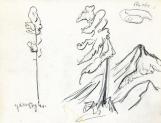 Credits:
Credits:
Moose Jaw Museum & Art Gallery
3
This is the ultimate in gestural sketches. It is a very quick rendering, with broad pencil strokes and very little attention to detail. There is absolutely no indication of light, value, or colour, and the picture appears wholly incomplete. This is a classic example of a sketch that is meant to capture the essence of the subject and nothing more. Grayson would likely return to this sketch and expand it into a finished silkscreen, but with such a bare rendering given, the finished painting might bear hardly any resemblance to the original subject.
4
Echo Rock Sketch
1951
Yellow Lake, B.C.
 Credits:
Credits:
Moose Jaw Museum & Art Gallery
5
A very bare sketch, taking no care to indicate her observations of light, colour, or value. It is a small rendering done on cardstock, roughly 1/7 the size of the finished print. It is obviously a preliminary piece, judging by both the size and the gestural quality.
6
Millar Lake Sketch
1950
Rocky Mountains
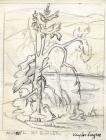 Credits:
Credits:
Moose Jaw Museum & Art Gallery
7
This drawing exhibits a slight improvement in detail over the last sketch. Meagre definition is given to the grass in the foreground, and the lake is not left as a blank white space, as in other sketches. Still, it is obviously a quick preliminary sketch, focused on recording the contorted shape of the tree for a future composition, leaving lighting and detail for later development.
8
Struggle Above Millar
1950
Rocky Mountains
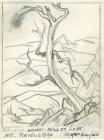 Credits:
Credits:
Moose Jaw Museum & Art Gallery
9
A return to the subject of trees, this sketch is also focused on capturing the contorted shape of the tree with little thought given to its surroundings. Unlike the previous, though, this one includes a minimal amount of shading. It appears that Grayson found it necessary to make note of the value of certain sections of the tree. The rocks in the foreground are also given a small amount of shading, unlike the rest of the scenery.
10
Summerland Apple Tree
1950
Summerland, B.C.
 Credits:
Credits:
Moose Jaw Museum & Art Gallery
11
This is a much more detailed and involved drawing. It takes specifics, like light and shadow, into account and makes use of cross-hatching. This sketch, in particular, was not developed into a silkscreen and could be considered a finished drawing, both because of the detail included and because she has sketched with ink rather than graphite.
12
Giant Steps
Circa 1930
Paradise Valley, AB
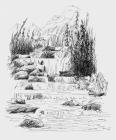 Credits:
Credits:
Moose Jaw Museum & Art Gallery
13
This is another example of a sketch that could be, and probably was, a finished piece. For one, it is drawn in ink. There is also attention given to the movement of the water with sweeping pen strokes, and by use of cross-hatching, she expresses the value of all of the scenery. Unlike in previous sketches, this one does not focus on a singular subject, but takes a broader look at nature.
14
Artist at Work
Circa 1937
Rocky Mountains
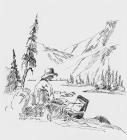 Credits:
Credits:
Moose Jaw Museum & Art Gallery






